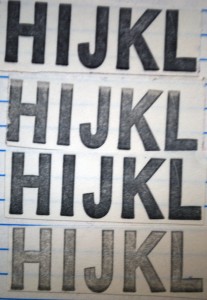Improve Print Quality and Print Density – Foam
When looking to improve print density, it requires looking at both the ink that is being used and also at the way the ink is being applied to the chosen substrate. Previously, we explored how manipulating the properties of an ink can greatly improve print density. With this article, let’s take a look at how the materials used in the metering process can also be manipulated to improve print density.
 Print density is the measurement of light reflected off of the substrate, or how dark the print appears after each press strike. When looking at the definition of print density it is easy to see how the materials that come in direct contact with the printing surface play a crucial role in print density quality. While there are many types of materials that can be used for metering ink to a substrate, here we will focus on custom foam metering applications.
Print density is the measurement of light reflected off of the substrate, or how dark the print appears after each press strike. When looking at the definition of print density it is easy to see how the materials that come in direct contact with the printing surface play a crucial role in print density quality. While there are many types of materials that can be used for metering ink to a substrate, here we will focus on custom foam metering applications.
Ensure that print density is maintained by accounting for the following:
Porosity/Flow Enhancement: Manipulating the porosity and/or flow enhancement of foam is important in print density, as this directly impacts the amount of ink that is transferred to the printing surface. By manipulating either the porosity or flow enhancement of the foam, one can, in turn, manipulate the amount of ink laydown in order to ensure uniform application during each printing strike.
Durability: As metering takes place, inevitably, ink rolls come in contact with the printing substrate and there is a certain amount of friction and normal wear and tear that occurs. When allowances are made for this and planned for in advance, one can ensure that the desired print density is maintained over a given number of applications. However, when the texture of the substrate is not accounted for, print density and over all print quality can be effected by the degradation of the foam within the ink roll. This happens when a soft or smooth foam comes in contact with an abrasive surface.
Solvents: Just as the printing surface effects the durability of an ink roll, the solvent(s) used in the creation of the ink can also impact the structural integrity of the foam roll. Properly matching the correct foam with the correct solvent ensures that the foam roll will:
- withstand predetermined variations in temperature
- withstand the solvent itself, which can be corrosive
- prevent excessive swelling of the foam that creates fluid loss
Dyes/Pigments: Engineering a foam that works seamlessly with the dyes and pigments used in the creation of an ink is an often over looked but crucial step in ensuring the desired level of print density is maintained. When a foam is not properly engineered to account for the pigments/dyes used in the ink roll a loss in print density/quality can occur due to the pores in the foam filtering out larger particles of the ink’s pigment. Conversely, pores that are too large can lead to a loss in print density/quality in later stages of the printing process.
By correctly pairing the foam and ink used in an ink roll, one can safeguard against a loss of print density/quality. This further ensures that materials are delivered on time, handled safely, inventoried correctly, and so on; creating a more productive work flow. Simply put, in many cases the answer to a print density/quality problem requires both a custom application and a custom ink solution.
